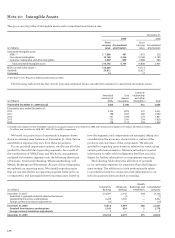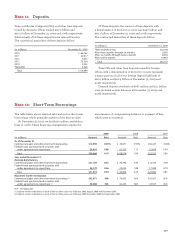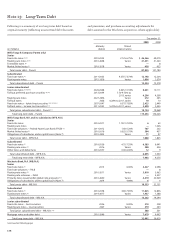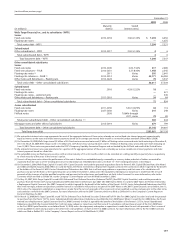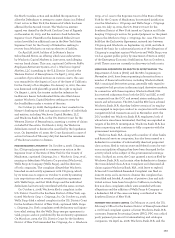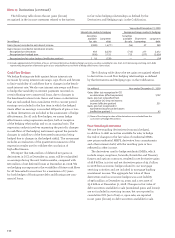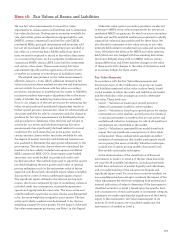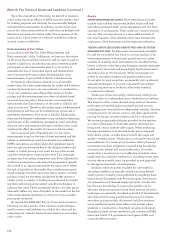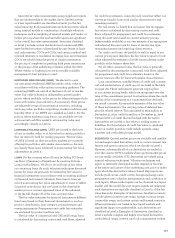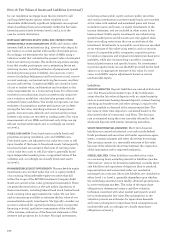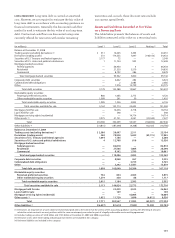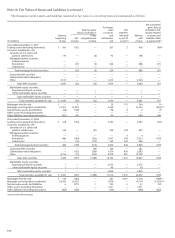Wells Fargo 2009 Annual Report Download - page 148
Download and view the complete annual report
Please find page 148 of the 2009 Wells Fargo annual report below. You can navigate through the pages in the report by either clicking on the pages listed below, or by using the keyword search tool below to find specific information within the annual report.
OCC entered into an Agreement to resolve the OCC’s investi-
gation into Wachovia Bank, N.A.’s relationship with PPC and
three other companies. The Agreement provides, among other
things, that (i) Wachovia Bank, N.A. will provide restitution to
consumers, (ii) will create a segregated account in the amount
of $125 million to cover the estimated maximum cost of the
restitution, (iii) will fund organizations that provide educa -
tion for consumers over a two year period in the amount of
$8.9 million, (iv) will make various changes to its policies and
procedures related to customers that use remotely created
checks and (v) will appoint a special Compliance Committee
to oversee compliance with the Agreement. Wachovia Bank,
N.A. and the OCC also entered into a Consent Order for
Payment of a Civil Money Penalty whereby Wachovia Bank,
N.A., without admitting or denying the allegations contained
therein, agreed to payment of a $10 million civil money penalty.
The OCC Agreement was amended on December 8, 2008, to
provide for direct restitution payments and those payments
were mailed to consumers on December 11, 2008. Wachovia
Bank, N.A. is cooperating with government officials to admin-
ister the OCC settlement and in their continued investigation
of this matter.
OUTLOOK Based on information currently available, advice
of counsel, available insurance coverage and established
reserves, Wells Fargo believes that the eventual outcome
of the actions against Wells Fargo and/or its subsidiaries,
including the matters described above, will not, individually
or in the aggregate, have a material adverse effect on
Wells Fargo’s consolidated financial position or results of
operations. However, in the event of unexpected future devel-
opments, it is possible that the ultimate resolution of those
matters, if unfavorable, may be material to Wells Fargo’s
results of operations for any particular period.
We use derivatives to manage exposure to market risk,
interest rate risk, credit risk and foreign currency risk,
to generate profits from proprietary trading and to assist
customers with their risk management objectives. Derivative
transactions are measured in terms of the notional amount,
but this amount is not recorded on the balance sheet
and is not, when viewed in isolation, a meaningful measure
of the risk profile of the instruments. The notional amount
is generally not exchanged, but is used only as the basis
on which interest and other payments are determined.
Our approach to managing interest rate risk includes the
use of derivatives. This helps minimize significant, unplanned
fluctuations in earnings, fair values of assets and liabilities,
and cash flows caused by interest rate volatility. This
approach involves modifying the repricing characteristics
of certain assets and liabilities so that changes in interest
rates do not have a significant adverse effect on the net
interest margin and cash flows. As a result of interest rate
fluctuations, hedged assets and liabilities will gain or lose
market value. In a fair value hedging strategy, the effect of
this unrealized gain or loss will generally be offset by the
gain or loss on the derivatives linked to the hedged assets
and liabilities. In a cash flow hedging strategy, we manage the
variability of cash payments due to interest rate fluctuations
by the effective use of derivatives linked to hedged assets
and liabilities.
We use derivatives that are designed as qualifying hedge
contracts as defined by the Derivatives and Hedging topic
in the Codification as part of our interest rate and foreign
currency risk management, including interest rate swaps,
caps and floors, futures and forward contracts, and options.
We also offer various derivatives, including interest rate,
commodity, equity, credit and foreign exchange contracts,
to our customers but usually offset our exposure from such
contracts by purchasing other financial contracts. The
customer accommodations and any offsetting financial
contracts are treated as free-standing derivatives. Free-
standing derivatives also include derivatives we enter into
for risk management that do not otherwise qualify for hedge
accounting, including economic hedge derivatives. To a lesser
extent, we take positions based on market expectations or to
benefit from price differentials between financial instruments
and markets. Additionally, free-standing derivatives include
embedded derivatives that are required to be separately
accounted for from their host contracts.
Our derivative activities are monitored by Corporate
ALCO. Our Treasury function, which includes asset/liability
management, is responsible for various hedging strategies
developed through analysis of data from financial models
and other internal and industry sources. We incorporate the
resulting hedging strategies into our overall interest rate
risk management and trading strategies.
Note 15: Derivatives
Note 14: Guarantees and Legal Actions (continued)


